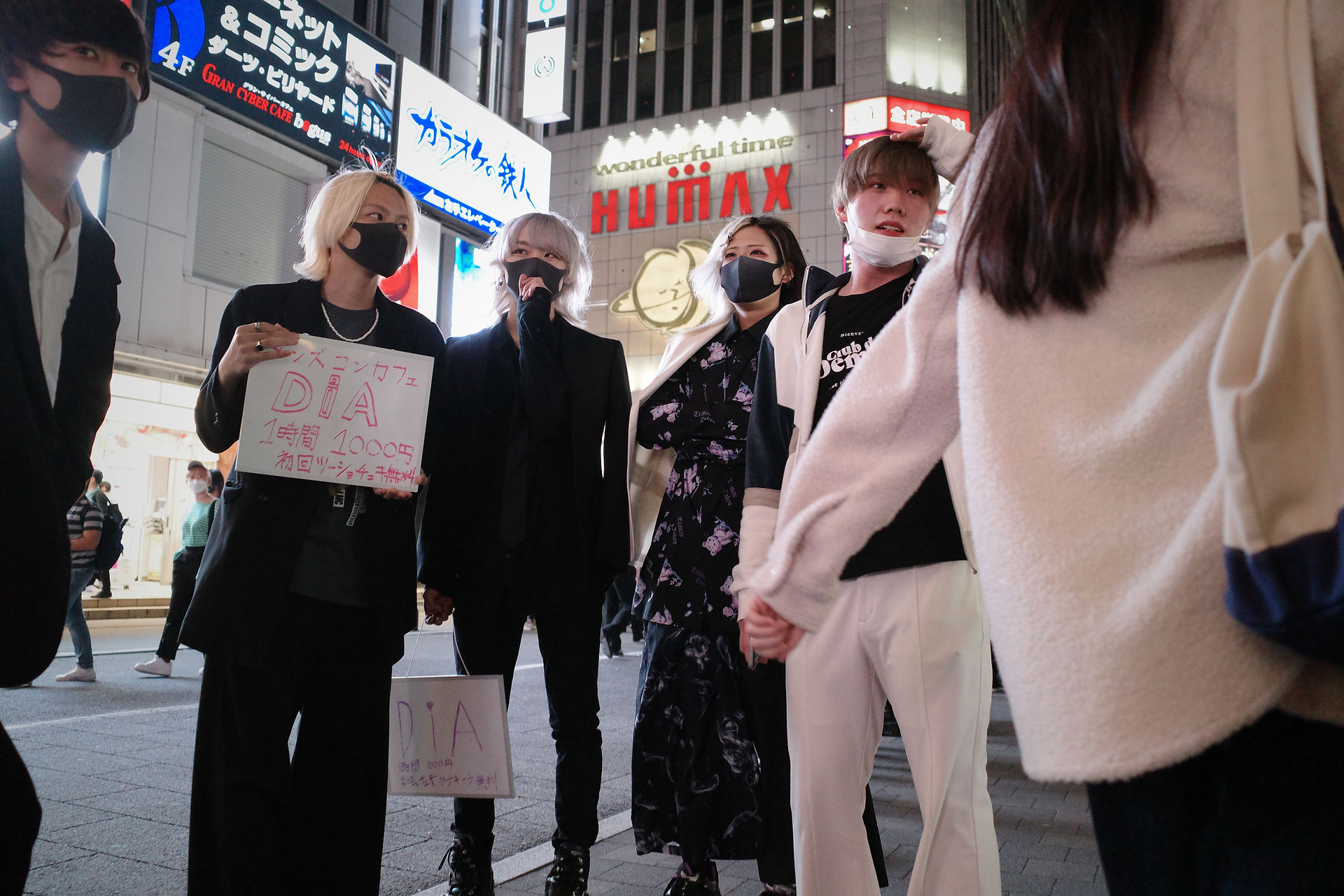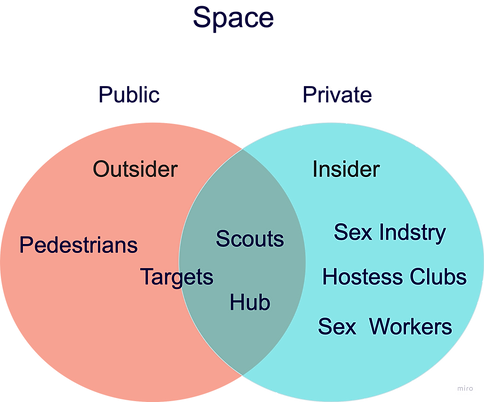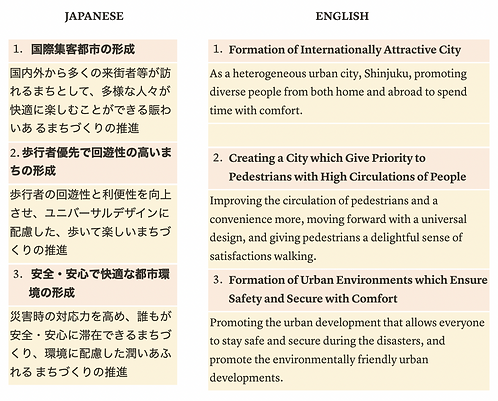
The Utilization of Space
Ways Scouts Transform Public into
Private Spaces
by Nanami
Scouts have two faces: public and private. They work as a bridge between those spaces. In the single layer, they cannot be scouts. In other words, scouts cannot exist without the overlap of public and private spaces. The fact that scouts are in-between public and private spaces prospers Kabuki-cho economy (Takeoka, 2013). Focusing on what is observable, which is public spaces, scouts have different ways of using public spaces from what pedestrians do. Scouts are not only using spaces but also creating conditions that are convenient for them.

As the diagram shows, scouts and their hubs are in the overlapping part. The fact that scouts are present in Kabuki-cho means there must be a target. What is interesting here is that targets are generated from pedestrians. In a nut shell, since scouts determine a target by scanning pedestrians’ qualifications as a worker, just one of the pedestrians is turned into a target. That is why targets are in-between public and the overlap.
The Relationship of Scouts in Public and Private Spaces
Utilizing Spaces for Their Benefits
Scouts use public spaces as their part of the workplace. They rather use it for their business fields for their interests. Once pedestrians receive prospects from scouts, they are turned into a target by scouts.
The work of scouts inseparably associate with industry in Kabuki-cho, at the same time, connect with people in public. What is unique about scouts' work is that it never achieve within the private world. In other words, they enlarge the fields to increase the number of targets they can encounter. They intrude into public from private and makes it personalized.
What scouts intruding into public from private means the scouts’ understandings of private and public is different from common. For example, what scouts do on public space contradicts the Shinjuku official policy made in constructing metropolises. According to the Shinjuku City website the Shinjuku ward office has published a proposal about urban maintenance and developments in the Shinjuku area. It includes Moa 2nd street which has a scouts’ workplace (2021). According to the section of objective of this project, it says

Taking a look at the proposal above, it is mainly for pedestrians not private-run businesses in which scouts engage. This proposal may be made to ultimately activate private-run businesses near public spaces. However, scouts work for their profits on where it is built for public, not private reasons.
Creating a Hub
In public spaces, scouts create a hub to look for targets and communicate with other scouts as their private spaces. Based on the hub, scouts work around there. Where hubs are located is public spaces since scouts are pubic guidance to lure women into industry in Kabuki-cho. They do not totally transform the spaces of hubs into public spaces but as the diagram above shows, scouts pull those spaces into part of the private realm of Kabuki-cho. However, when scouts leave the places, it is no longer a hub but completely a public space. In a nut shell, scouts themselves are the ones who turn the space into a non-public space, a hub (Takeoka, 2013).
Also, a hub is a ubiquitous space, wherever the scouts have certain conditions to approach targets, urban spaces can be turned into perfect scouting spots.
Personalizing the Space
Scouts turn public spaces into private spaces. It sometimes goes even further personalized. For example, one scout was eating a burrito in one hand during his break, at the same time, he kept an eye on pedestrians to find targets. While eating something in public spaces is against manner (Harada, 2018) in Japan, scouts do it. This fact leads to the way scouts see the space is different from pedestrians. Since what pedestrians think public is private space for scouts, they may not have sense of what pedestrians think as taboos.
As the video above shows, he has a burrito in his hand and is approaching a target. He is working to lure a target, at the same time, he relaxes in his workplace because the space is "his" personalized spaces not urban spaces.
Also, at this Covid time, it is manners to wear a mask when talking with others to care about feelings of others so-called 忖度, being considerate to others, rather than protecting themselves. Deviating from common sense is kind of taboo in Japan (Yoshitake, 2018). While the scout was eating a burrito, he never tried to cover his mouth but approach the target. Analyzing those behaviors, the way scouts see spaces is more personalized than pedestrians.


Conclusion
The way scouts see spaces is different in terms of personalizing. Analyzing what scouts do and how it is perceived from public, they are totally opposite and can be taboos in Japan. Considering the aspect of taboos, being considerate or not in this context may relate to extra legality and have further room for consideration.
INTRODUCTORY PAGE
Sections
the utilization of space
ANALYSIS PAGE
